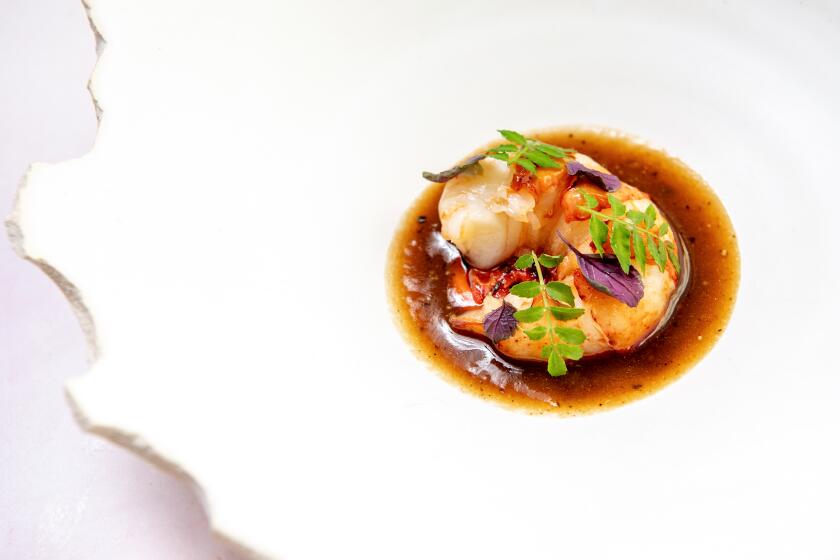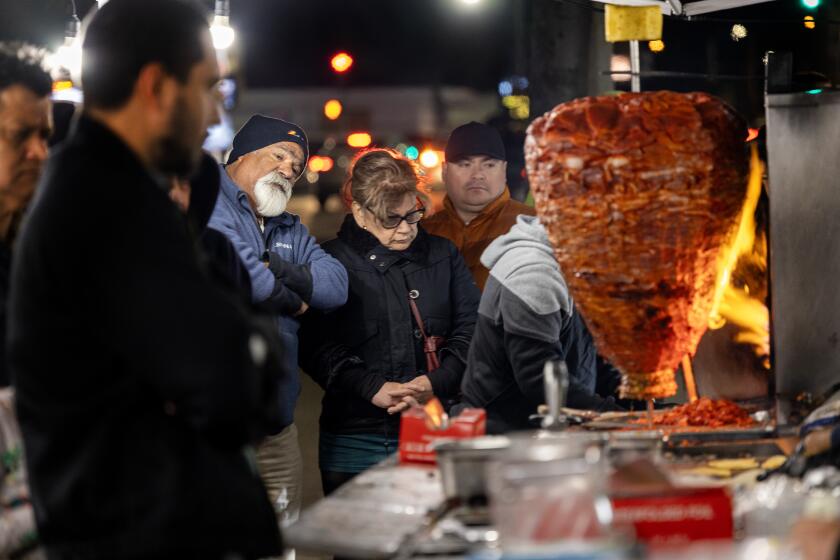Grape Crop Lifts Hopes for ’05 Vintage
As California’s vintners pull in the last of this harvest’s grapes, 2005 is turning out to be a very good year for wine.
The crop is plentiful, the largest since 2000. A long, cool growing season and picture-perfect weather during much of September and October produced high-quality grapes that some winemakers say are reminiscent of the well-regarded 1997 crush.
“This could be one of the vintages that people will really talk about,” said Jamie Lubenko, executive director of the Amador Vintners Assn. in the Sierra foothills.
At Wally’s, a large wine store in Westwood, “we are hearing only good things,” wine buyer Gary Fishman said. “This could be on par with the vintages of ’97 and ‘94,” years prized by connoisseurs.
That’s good news for the $15-billion California wine industry, which in 2004 emerged from a three-year slump but is now fighting a growing flood of imports that account for 26% of domestic wine consumption. The healthy harvest comes at an important juncture for the state’s winemakers, who are searching for new customers around the globe and in the United States, aided by a recent U.S. Supreme Court decision that has led to liberalization of interstate wine-shipping laws.
Throughout California, preliminary estimates place the 2005 grape crush at 3.2 million tons, about 15% bigger than last year. The crop was so large that wineries don’t have enough room to turn all the grapes into wine and some growers will leave fruit on the vine because they won’t be able to find buyers, said Joseph Ciatti, owner of Joseph W. Ciatti Co., the nation’s largest grape and bulk wine broker.
“Consumers are going to get a lot of good wine at attractive prices,” said Thomas Klein, chief executive of Rodney Strong Vineyards in Healdsburg. White wines from the 2005 crush will begin appearing in six months and red wines in one to three years.
Despite the large harvest, California’s wine industry is unlikely to fall back into the glut that brought low prices and bankruptcies from 2000 to 2003. A series of small crops in recent years has drawn down inventories of inexpensive bulk wine, experts say. In addition, about 100,000 acres of vines have been torn out in the last few years. A spate of winery deals since the glut is seen as a sign of the industry’s revival.
Aided by favorable currency rates, California also is selling more of its wine abroad, helping to soak up any excess domestic production. U.S. wine exports, 95% of which come from California, surged 28% in 2004 to $794 million. The state exports about 20% of its production, nearly double what it sent overseas a decade ago, Ciatti said.
Although much of the harvest is already sold under long-term contracts that determined the price before the grapes were ready for picking, opportunistic buyers are getting great prices for spot-market grapes.
Greg Popovich, a Palos Verdes Estates entrepreneur who owns the Castle Rock label, said he had been buying Sonoma County Cabernet Sauvignon fruit for $700 to $1,100 a ton, about half what he paid last year.
“This is just great for us because we don’t have long-term contracts,” Popovich said.
Popovich also is a big buyer of bulk wine for the label, and he figures that will be “plentiful, good,” and less expensive than in recent years, during which small harvests have gradually tightened supplies.
Not everyone, however, shared the view that this year’s harvest was uniformly good.
Much of the wine is still in fermenters and it’s hard to make predictions about its quality so early in the process, said Lisa Minucci, sommelier and vice president at Vintrust, a San Francisco wine purchasing and cellaring firm for collectors.
In a nod to Dante, Bonny Doon Vineyard owner Randall Grahm called this year’s harvest a “Vinferno” because meticulous growers who thinned vines and didn’t overproduce were “rewarded with beautiful grapes.”
“But those who left too much fruit on the vine grew grapes that will be punished with meager and thin wines,” said Grahm, whose Santa Cruz winery makes wine from vineyards in Monterey County and San Joaquin Valley. Grahm suspects that much of the poorer wine will wind up on the bulk market, to be sold cheaply or blended with better vintages.
California’s red wines should be especially good this year, said Peter Marks, a Napa Valley wine expert and one of 23 certified Masters of Wine in the United States.
The cool weather allowed the grapes to develop ripe flavors without building high sugar levels that produce heavily alcoholic wines, said Marks, who also is wine curator for Copia, the American Center for Wine, Food & the Arts in Napa. The fertile nature of this year’s crop was evident in the museum’s small demonstration vineyard, where vines heavy with fruit produced almost four barrels of wine this year compared with 1 1/2 in 2004, Marks said.
“The quality is outstanding,” he said. “People are more excited than normal.”
More to Read
Eat your way across L.A.
Get our weekly Tasting Notes newsletter for reviews, news and more.
You may occasionally receive promotional content from the Los Angeles Times.







